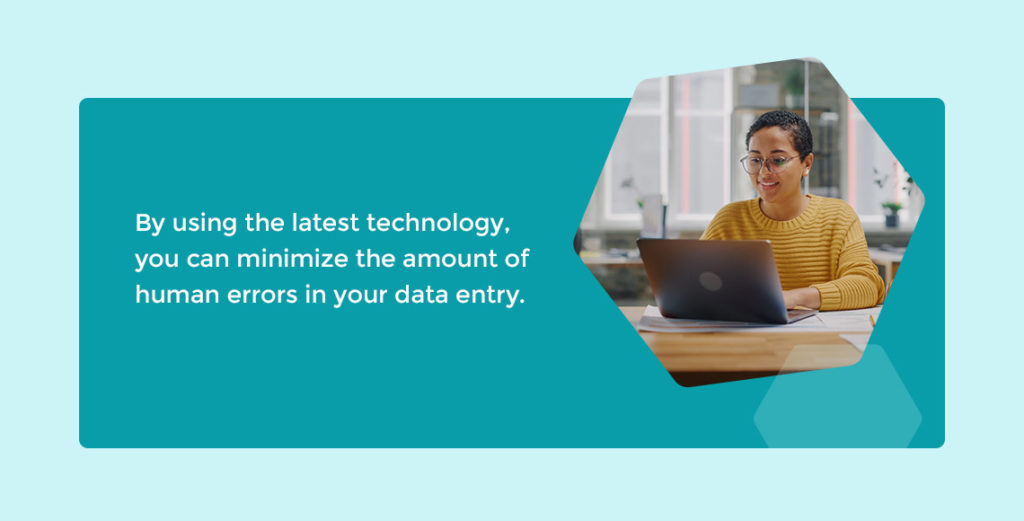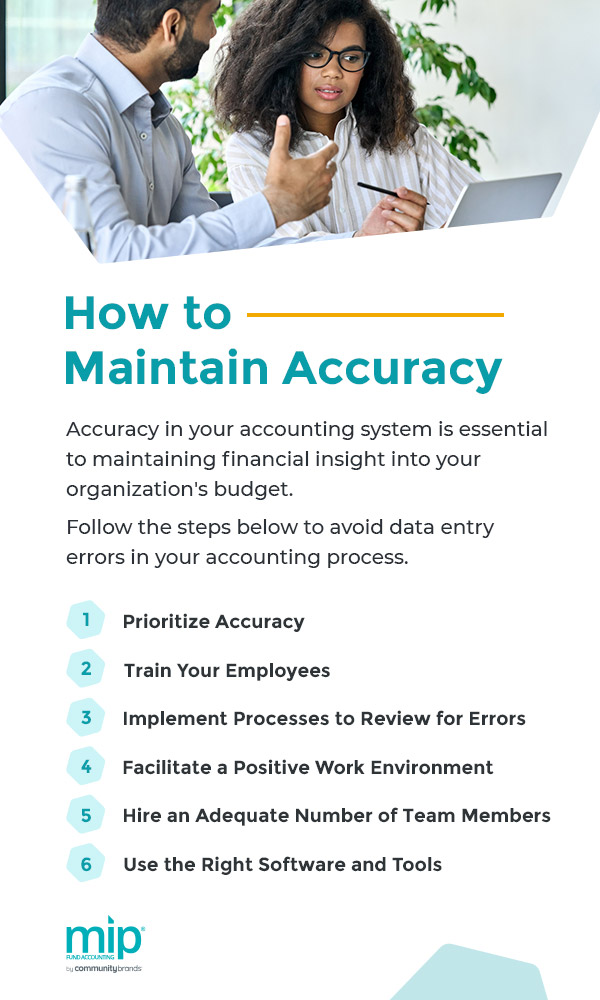Reading Time: 8 minutes
Data entry is a critical everyday task for accounting teams in any organization, including nonprofits, schools, governments, and healthcare organizations. Your financial information is dependent on data entry, which means a single error can significantly impact your organization. Unfortunately, data entry is still often a manual task. This can leave your organization’s data entry vulnerable to human error.
To reduce errors in data entry, you should understand the latest technology you can use to automate the process, along with which types of data entry errors are most common, the potential cost of these errors, and how you can maintain accuracy.
Types of Data Entry Errors
Regardless of whether your team double-checks their data entries, mistakes can happen. To prevent data entry errors in your organization, you should first be aware of the different types of errors you could face:
- Errors of principle: Errors of principle happen when someone misapplies or misuses an accounting principle. For example, an error of principle may occur when an expense is inaccurately reported as a tax write-off.
- Reversal errors: Reversal errors arise when a team member records a transaction as one type, but it is actually a different type. If you record a transaction as a credit purchase but it is actually a debit purchase, this would be a reversal error. You may miss this error while entering invoices as payments or refunds since the trial balance will be accurate.
- Errors of omission: Errors of omission are when a transaction is unintentionally left out of accounting records. Typically, these errors occur when someone loses a transaction document or receipt. These mistakes can be some of the most challenging to detect.
- Transposition errors: Transposition errors can happen when an employee enters information in the wrong order. Usually, these data input errors happen more often while typing numbers than words. This error tends to happen when an employee is typing too quickly and does not notice the mistake. An employee might mean to type 456, but they type 465 instead.
- Errors of duplication: Errors of duplication occur when you enter data more than once, charging for or processing the same amount more than once.
- Transcription errors: Transcription errors are when someone enters information the wrong way. Typically, these mistakes come about more when transcribing words and less often when transcribing numerical data. Types of transcription errors include deletion, repetition, and typos. You may notice these errors most in word processing programs, and they tend to happen when employees are typing quickly and hit the wrong key without noticing.
- Errors of commission: Errors of commission arise when someone labels a transaction with the wrong subsidiary ledger. For example, if you apply a payment toward the wrong invoice, this is an error of commission. These flaws can negatively impact your relationship with donors, vendors, or partners.
- Data misinterpretation: Data misinterpretation errors are when someone accidentally mixes up numbers and letters. When recording a code or password, you could mix up a number and letter, such as the number 0 for the letter O or a capital I for a lowercase L.
- Compensating errors: Compensating errors come about when someone compensates for a data entry error by offsetting another incorrect entry.
- Subsidiary entry errors: Subsidiary entry errors arise when you enter a transaction incorrectly, such as typing the wrong amount.
- Incorrect data formatting: Incorrect data formatting is when you enter the correct data multiple times or in the wrong field. Similarly, errors due to incorrect data formatting can occur when someone inputs unnecessary information.
- Representation inconsistencies: Representation inconsistencies happen when there are inconsistencies in units and measurement formats like addresses, dates, and times.

Cost of Data Entry Errors
Unfortunately, data entry errors can be costly to your organization. Even a seemingly minor mistake can cause considerable damage. Inaccurate data takes time and resources to address, and if you miss the error, it could lead to lost revenue or legal problems.
The costs of data entry errors only increase as time goes on and the mistake goes uncorrected. The cost of verifying your data’s accuracy immediately after entry tends to be far below the cost of correcting an error or allowing it to go uncorrected.
Costs for addressing data quality issues include:
- Billing errors: If you need to bill vendors or suppliers, data entry errors could lead to billing errors. If you include mistakes in the final billing, this could lead to monetary losses.
- Quality control: When you have staff members or systems in place to identify and correct errors, you should factor in the costs of these systems.
- Uncaught errors: If your organization misses errors and they go uncorrected, you may incur a wide variety of costs as a result, depending on how the mistakes affect the patrons you serve.
- Back-office errors: Back-office errors can lead to costs that are difficult to quantify and may not be evident immediately. These costs may include operational losses from decisions made based on incorrect data, lost revenue from low customer satisfaction, and regulatory risks from erroneous recordkeeping.
With the potential cost of data entry errors, it’s essential for your organization to develop planning strategies regarding your data and minimize these mistakes. The cost of preventing inaccurate data or data entry errors is far more affordable than fixing an error retroactively. This is why we recommend investing in the right technology.

Using the Latest Technology and Updating Your Systems
Some organizations use the latest technology to extract data and reduce the workload for staff regarding data entry. This latest technology may include software like optical character recognition (OCR) and intelligent character recognition (ICR). By using the latest technology, you can minimize the amount of human errors in your data entry. Automatic error reports can check the input data’s quality based on your predetermined parameters, which you can use to quickly address any errors that arise.
Of course, no matter how advanced your technology, your systems can only be useful if you keep them updated. If you haven’t updated your system, it could leave your data and organization vulnerable. Upgrade your systems regularly to ensure your technology and infrastructure function smoothly for your data management processes. Automating and upgrading your technology helps you maximize its benefits and improve every tool’s functionality.
At MIP®, we offer the accounting system your organization needs to mitigate data entry errors in accounting and manage your finances.

How to Maintain Accuracy
Accuracy in your accounting system is essential to maintaining financial insight into your organization’s budget. By maintaining accuracy, you can make informed decisions before you invest in new marketing plans or resources. When you have accurate records, you can maintain compliance, retain a steady cash flow, and entice potential investors or donors.
To maintain and meet grant eligibility requirements, you need an accurate accounting system. The fewer mistakes, the better off your organization will be during tax season and audits. Accuracy helps you avoid potential fees or fines, which saves your organization in the long run. Follow the steps below to avoid data entry errors in your accounting process.
1. Prioritize Accuracy
Your team should understand how valuable your data is and prioritize accuracy over speed. Though speed is important to maintaining a healthy workflow, accuracy is essential for your organization’s data entry and long-term success. Rushing detail-oriented tasks like data entry could lead to devastating errors.
Rather than focus on speed, encourage your team to prioritize accuracy. You may want to set accuracy goals and targets rather than time goals, for example. Keep in mind that these targets should be realistic, and you should regularly evaluate them. While getting the job done on time is great, getting the job done right is crucial.
2. Train Your Employees
The most important asset to your organization is your team. However, your employees can also be one of your organization’s liabilities if they lack the proper training to perform their duties correctly.
Thoroughly training your employees on data entry and how to use your software is essential for maintaining accuracy. Before an employee enters data, train them to understand why this information is important and how inaccurate entries can negatively impact your organization. When employees understand the information’s relevance and the importance of their work, they will feel a greater sense of responsibility during the data entry process and focus more on accuracy.
3. Implement Processes to Review for Errors
Have processes in place that encourage your team to double-check their entries for possible errors, such as deleted data or typos. It should be standard procedure for your team to double-check completed work, especially for data entry.
Your organization’s process for data entry should also involve a manager or senior employee reviewing the work for accuracy. Though this step may not be feasible for large amounts of data, conducting detailed checks regularly can pinpoint potential areas of improvement.
4. Facilitate a Positive Work Environment
A positive work environment with good working conditions helps your team perform their work efficiently and safely. Factors like discomfort and fatigue can impair a staff member’s ability to work. For example, fatigue due to muscle strain may lead to an employee clicking the wrong key. Fortunately, you can prevent these issues by:
- Purchasing wrist support and ergonomic chairs for staff
- Offering your team regular breaks
- Providing your team with a comfortable workspace
- Adding appropriate computer monitors and lighting to reduce eyestrain
The goal of facilitating a positive work environment is to help your team work more accurately for longer. Part of a positive work environment also includes giving employees realistic goals and targets. Unrealistic targets can cause stress for your team, so make sure you determine what a team member can realistically accomplish in a day when setting your goals and targets. When you have a lot of work to complete, delegate appropriately and give attainable deadlines.
5. Hire an Adequate Number of Team Members
Ensure you hire enough staff to successfully manage the workload. Even if your current staff is incredibly capable and efficient, everyone has their limits and can be more prone to mistakes when overworked or juggling too many responsibilities. If employees are frequently overworked, mistakes like data entry errors may arise more often. Worse, this could lead to employee turnover, which will mean greater costs to your organization as you’ll need to recruit, hire, and train new employees to replace these staff members.
To help your organization run smoothly, be sure your team includes enough members to effectively handle the amount of work you need to perform.
6. Use the Right Software and Tools
While the right software doesn’t replace your team, a proper accounting solution can reduce your team’s workload and the odds of data entry errors. The right software gives your employees more time to review and analyze data entries so they can address and correct any errors quickly.
Almost half of nonprofit professionals use as many as six digital tools to perform their jobs and accomplish their goals. Often, these siloed tools lead to decreased efficiency, and many nonprofit professionals spend a significant portion of their day managing multiple systems. This is why we offer MIP People, our payroll and HR solution. With MIP People, your organization no longer needs to rely on importing and exporting data, reducing human error and preventing duplicate entries.
MIP People comes with people management capabilities through our human resources (HR) module. In the HR module, you can make changes and updates to employee information and streamline the payroll process. Integrate payroll and quickly and easily complete HR reporting, including EEO, FMLA, and ACA. Your HR team can efficiently track employee data, like employee education, certifications, benefit plan adjustments, and review dates.
The Employee Web Services (EWS) module gives employees 24/7 access to their employee messages, benefits information, and paystubs. This module also streamlines timesheet entry and accommodates different entry preferences. With this portal, your HR team can focus on managing your team rather than responding to dozens of information requests. With our payroll module, your organization can accurately pay employees on time. Direct deposits are automatically recorded, allowing for effortless report generation and tracking without a data export.

Get a Free Demo From MIP®
At MIP Fund Accounting®, we understand the importance of reducing errors in data entry. That’s why we offer the accounting solution your organization needs. Whether for a nonprofit, school, healthcare organization, or municipality, our leading fund accounting software can help you achieve your mission.
Along with accounting software, we offer various services specifically designed to help organizations manage complex accounting. With comprehensive financial tracking, your organization can make informed decisions and operate efficiently.
Our platform was purpose-built for nonprofit organizations rather than adapted from existing solutions. Designed with organizations like yours in mind, it’s flexible, scalable, and secure, offering every feature you need for fund accounting. Request a free demo of MIP Fund Accounting® today to learn how our solution can help your organization reduce data entry errors.
Share this post





